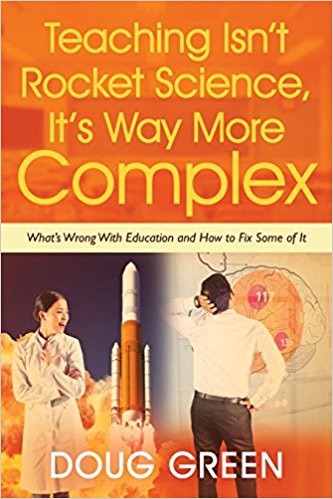Author Archive
Sunday, December 23rd, 2018
In order to spread the word about how policymakers and corporate leaders are messing up education and what we can do, I published a book this year. I’ve been flattered by the positive feedback so if you haven’t read it yet it’s time to take a taste. Just scan the table of contents below and find your favorite topic. If you are having a hard time deciding, go for chapter 19 as it’s a topic I haven’t seen covered elsewhere. Thanks for your support.
Here Is the Deal
- Below are the chapter titles from my book Teaching Isn’t Rocket Science, It’s Way More Complex: What’s Wrong With Education and How to Fix Some of It. As my Christmas gift to you, I’m offering the introduction and a free chapter of your choice with no strings attached. Just select your favorite and send me an email with the chapter number to dgreen@stny.rr.com. The chapters are all self-contained so they can be read in any order. If you like the free sample you can purchase the book in softcover or Kindle editions at Amazon. You can also read an executive summary on my blog.
Chapter Titles – Just Pick Your Favorite
- 2. Education Isn’t Rocket Science, It’s Way More Complex
3. How to Cheat on Standardized Tests and Not Get Caught
4. Are You Smarter Than Bill Gates?
5. Failing at the Business of School
6.Achievement Gaps and Ethnic Groups
7.The Drive to Fire Underperforming Teachers Will Not Improve Our Schools
8. Special Education Shouldn’t Be Special
9. If Gifted Lessons Are So Good, Why Can’t All Students Participate?
10. Education Drugs: Learning on Steroids
11. Kindergarten is the New 1st Grade
12. Math Class: The Champ at Slowing Down the Fast Learners.
13.Not Ready for College? Flunk Gym.
14.Coding for Everyone? Are You Serious Mr. President?
15. SAT’s for All? One More Bad Idea From the Political Elite
16. Forging Strong Relationships With Students Should Be Top Of Your To Do List.
17. Good Luck Learning a Foreign Language in American Schools?
18.The Arts: One More Victim of Common Core Testing.
19.Teachers/Parents: don’t run away from discussing porn.
20. It’s Time For An Assessment Revolution: Give Students Access To The Internet
In Exams And Scrap Traditional Grades.
21. Why Would Anyone Let Their Kid Play Football or Anything Else?
22. Bathrooms and Locker Rooms: A New Battlefield
23. The Drive To Fire Underperforming Teachers Will Not Improve Our Schools
24. If Education Is Going To Improve, We Must Work On Improving Initial
Teacher Training
25. Five Ways Hectically Busy School Leaders Can Stay On Track
26. Think About How To Do It Right, Rather Than Doing It Over
27. As A Teacher, It’s Important To Get Good At What You Don’t Like To Do
28. A Word About Flipping Your Class
29. Can We Save Opera? The Barriers to Digging the World’s Greatest Art Form
Posted in Doug's Original Work | Comments Off on My Christmas Present to You – A Free Chapter From My Book
Sunday, December 16th, 2018
Just in time for Christmas. Here is an executive summary of my recent book. Based on the feedback I received so far, it would make an excellent present for any educators and parents with kids in school. Also, consider getting a copy for any policymakers you know.I hope you like it.
Click here to buy at Amazon
1. Introduction
- Teaching is tricky business. If it were as easy as rocket science, which we seem to have figured out, all students would be learning as fast as their individual brains would allow. This implies that they would learn at their own individual pace, which would cause the gaps between the faster learners and the slower learners to gradually increase.
- Unfortunately, our current set of reforms driven by the corporate/ political complex gives the same tests to students each year based on their born on date, regardless of their ability. It also expects teachers to close the gaps between slow and fast learners. One way to do this is to slow down the fast learners. In this book, Dr. Green explains why the current reforms and out-dated teaching methods need to go and just where we might head.
2. Teaching Isn’t Rocket Science; It’s Way More Complex
- It’s clear that we understand how rockets work as we have sent them all around the solar system and beyond. The human brain, however, which is the learning playground for students and teachers is much more complex and less understood. Promising ideas in education spread slowly, if at all, because of a resistance to change and federally imposed standardized testing. Thanks to the media, however, the public doesn’t realize this and they think that teachers are generally doing a bad job. They also think that all students should be able to achieve at high levels, which is nonsense. We all know that some students are more capable at cognitive tasks than others.
3. The Pressure On Teachers To Get Good Test Scores Makes It Inevitable They Will Cheat
- When the government encouraged by business leaders imposes high-states tests on schools, three things can happen. First, some will cheat and many have. Second, most will try to game the system with endless test prep that brings with it a lot of bad teaching practice. Finally, some will just fail. Schools will be closed and careers will be negatively impacted or ended altogether. This chapter documents some of the cheating and explains the different ways that teachers can cheat. It also suggests that teachers work to create engaging lessons and let the tests take care of themselves. If they do, test scores are unlikely to go down and just might go up.
4. Are You Smarter Than Bill Gates?
- Bill isn’t the only member of the corporate class pushing for test-based accountability, he is just the most famous and has the most wealth to push his ideas. Dr. Green suspects that when Bill wants to cure some disease, he reaches out to experts in the field. When it comes to education, it seems that he thinks he already knows the answers. Meanwhile, it’s hard to find any real expert in the field who thinks the current reforms are a good idea.
5. Failing at the Business of Schools
- Unlike businesses, schools cannot control their raw materials. They just take the students that their parents drop off. Most are also run from the top by a school board composed of elected volunteers who for the most part lack any serious educational expertise. For these reasons, trying to hold schools to business standards makes no sense. It also makes no sense to hold all schools to the same standard as their raw materials vary.
6. Achievement Gaps and Ethnic Groups
- When advocates for blacks, Hispanics, and poor kids see that that whites and Asians perform better on standardized tests, they expect schools to work on closing the gaps. Ironically, if schools did a perfect job of letting every student learn as fast as possible, the gaps would increase. Doug maintains that the best way to close the gaps is to slow down the fast learners, which some schools do well. He also points out that the subgroups themselves are arbitrary and don’t make much sense. For example, why are Spanish speakers the only group based on the language they speak when more people speak English and Chinese? People from China and India are very different in appearance and culture, yet they are in the same group.
Posted in Book Summaries, Education Books, Leadership Books | Comments Off on Teaching Isn’t Rocket Science, It’s Way More Complex: What’s Wrong With Education and How to Fix Some of It by Doug Green
Thursday, December 13th, 2018

Tips for Teaching Your Kids How to Take Quality Photos by Emily Ford looks at some of the top tips for encouraging your kids to get into photography. Whether you’re a professional photographer or a keen amateur, you can easily implement these with your children.
Introduction
- Photography is a skill that can take many years to perfect. The rewards can be great, but it takes time and effort that isn’t always available if you have a busy schedule. If your kids start showing an interest in photography, you can do them a huge favor by teaching them how to take quality photos early on. Doing so will give them an excellent foundation for developing their skills as a photographer. It can also bring you closer together as you enjoy a shared hobby.
1. Have Fun
- Photography shouldn’t be a chore, particularly at a young age. There’s much to be said for the charm and unique perspective that a child can bring through a lens. For both of you, it’s important that this pastime is something you can enjoy together. Encouraging your child to have fun with the camera is invaluable.
2. Practice Together and Review
- This point is somewhat linked to the first point. You’ll want photography to be something you practice together at times, sharing that fun and excitement. With the invent of digital photography, you don’t have to worry about wasting film. Therefore, you should encourage them to take as many photos as they like. You can review them together and look at which ones are good and why.
3. Holding the Camera
- It may seem like common sense to you, but holding a digital camera isn’t always intuitive to young photographers. Take the time to show your child how to hold a camera. This allows them to steady the camera and capture better photographs. It also means that they’ll be able to frame their shots better. Keeping the camera straight is important and comes from holding the camera correctly.
4. Backgrounds and Foregrounds
- Many adults struggle with these aspects of photography, so forming good habits from an early age can be incredibly useful. Teach your child to look at the elements that make up the background and foreground. Show them how to look for clutter and unnecessary things that will mean photos look messy.
5. Get in Close
- When using a camera, many people seem reluctant to move too close to their subject. They’ll rely on zoom lenses or simply take the photo from a distance. Doing this means that the end result lacks focus. Show your kids that it’s ok to get up close to the subject (provided they don’t mind that!) to give a clearer focus on the subject.
6. Look for Back Light Situations
- Taking a photograph with lots of light behind your subject will cause your subject to come out too dark. Common situations occur where the sun or a window during the day is behind your subject. To avoid this you can tell your camera to use the light coming from the subject to determine exposure rather than light coming from a bright background. Modern cell phones make this easy. All you have to do is tap on your finger on the subject on your screen and the cell phone will use the light coming from your subject to adjust exposure.
7. Landscape or Portriat
- Make sure your child understands the difference between holding the camera so the long side is up and down (portrait) or left and right (landscape). As the names imply, the first is fine for taking pictures of people fairly close up, while the second is best when the content of the photo contains mostly backgrounds. A lot of people take too many pictures in the portrait position as this is the way they usually hold their cell phone when they use it. Most photos, however, will look better in the landscape position.
7. In Conclusion
- Of course, these are just some of the basics of photography that can help your child improve. Depending on their age, you may also want to cover things such as how aperture, shutter speed, and ISO work together. However, the more complex elements should be saved until they’re ready and able to learn. Also, be sure to have your children evaluate their own work. This will help them become better critical thinkers.
Emily Ford
- Emily is a blogger for thephototeam.co.uk. She has been a regular contributor to sites talking about the newest trends in photography and event management. When she’s not writing, she enjoys, cooking, hiking and pretty much anything outdoors.
Posted in Guest Posts | Comments Off on Tips for Teaching Your Kids How to Take Quality Photos by Emily Ford
Friday, December 7th, 2018
Chiropractic Adjustments: Real Treatment or Real Quackery? by Reyshimar Arguelles takes on a controversial topic. Since my own experiences with chiropractors have been positive I decided to do this guest post. Be sure to ask your chiropractor if he or she will refer you to another type of physician if your problem isn’t one they can fix. Mine did once even though it meant less business for him.
Introduction
- As a species, humans are constantly looking for ways to improve our way of life and the way that we do things on a daily basis. We are constantly looking for solutions to problems and better ways to execute processes. Down to the very core, human history has always been a recurring trial and error scenario.
- Sometimes, we’re able to come up with breakthroughs, and sometimes, we fail and then it’s back to the drawing board. One realm of living where we’re very particular is the realm of health. Isn’t it strange? That we’ve lived for millennia and yet, we’re still trying to learn new things about our bodies and how to better treat them.
Watch Out for Fads
- This seemingly-constant pursuit for new knowledge often gives rise to a multitude of fads. Things like ketogenic diets, alternative medicine, yoga, and quite recently, chiropractic adjustments sprouted like mushrooms in a forest. Those who propose these new methods always claim that there’s a scientific basis for these things. Sometimes, they’re legitimate. They truly improve the way we live and the effectiveness at which we’re able to address the plethora of problems that plague our lives.
-
- But sometimes, these fads turn out to be hoaxes, quackeries, and falsehoods that were constructed with the purpose of using hype and mere anecdotal evidence in order to get people to jump on the trend. So, what category do chiropractic treatments fall under? First, we need to define some things.
What exactly is a chiropractic adjustment?
- According to this article, a chiropractic adjustment is the manipulation of vertebrae that are unable to function properly. The ultimate goal of giving a chiropractic adjustment is to increase the range of motion, improve bodily functions, and to reduce the likelihood of nerve inflammation.
When is it administered?
- Chiropractic adjustments are usually administered in order to address neck pain, lower back pain, headaches, recurring strains, sports injuries, and injuries that are sustained from car accidents. It’s also important to note that spinal adjustments are extremely dangerous when done improperly. It is because of this that it’s of paramount importance that you only get your adjustments done by fully trained professionals like the New York Chiropractors.
The Verdict
- Chiropractic adjustment should not be the end-all-be-all solution for back pains. It is not the miraculous treatment that many would have you believe it to be. However, its benefits cannot be denied. Is it a real treatment? Yes, it is, but not to the extent that many of those who try to stoke the hype would tell you. Studies have not yet confirmed its effectiveness for pain relief or even as a treatment for chronic back pain for that matter.
- It has, however, proven to be beneficial in many ways. For the purpose of maintaining bodily functions, range of motion, and flexibility, chiropractic adjustments will definitely be beneficial to you. This should be taken in the context of a component of a solution, not a singular, one pill cures all solution to your problems. It’s important that you do not undergo a chiropractic adjustment if you have osteoporosis, chronic back pain, or even simple back pains as these may worsen with improper treatment.
Reyshimar Arguelles
- After graduating from university, Rey worked as a journalist. He covered various beats, including politics and crime. Later, he would work as a freelance writer on the side. He usually writes academic papers as well as blog content. You can reach him at reyshimar.arguelles92@gmail.com
Posted in Guest Posts | Comments Off on Chiropractic Adjustments: Real Treatment or Real Quackery? by Reyshimar Arguelles
Monday, December 3rd, 2018
Your Starter Guide to Maker Spaces by Nicholas Provenzano tell the story of how he started and built a successful maker space at his school. His guidelines explain what one is, who can help you build one, where it should go, and what to put in it. He explains how it can promote project-based learning and turn failure into a positive thing. Every school should have a copy.
Introduction
- Since making doesn’t have a set curriculum, it should be no surprise that this book is written by an English teacher. The goal is to have students use different tools to demonstrate understanding. You don’t have to be an expert to turn your students lose and it’s ok to fail. This book features Nick’s experiences rather than a pile of research. He claims to be a tinkerer rather than an expert and hopes that you can draw on his work to help jump-start your own and the work of your students.
1. So, What is Making?
- Nick’s definition of making is that it is the creation of something new that was not there before. By being broad and vague it is not constrained. This definition also makes it more inclusive so the everyone can make with anything you can find along with computer code. It is also vital that you ditch the idea that making is for STEM classes. You need to add the arts (STEAM) as the arts bring everything together. You want students to be creators, not just consumers.
- Since some students don’t have a supportive making environment at home, schools need to provide one. They all need to experience problem-based lessons to prepare for life after school. Another key is that teachers have to see themselves as makers. At the least, they make lesson plans. They also make other things and need to be role models when it comes to making. There is also an element of storytelling as just about anything you make has a story associated with it.
2. I Know What Making Is, but Why Should I Care?
- In many schools students don’t have much choice about what they do or study. A maker space gives them choice and freedom if they are making what they want. Creativity and innovation are also often eliminated from the curriculum. Not so in a maker space. You should also design your maker space to support collaboration. Businesses want all of these things and many schools don’t try to build them into students’ lives. Finally, a maker space should be a fun place for students to be. There is no reason why school can’t be more fun than it already is and maker spaces can help.
Posted in Book Summaries, Education Books, Leadership Books | Comments Off on Your Starter Guide to Maker Spaces by Nicholas Provenzano









